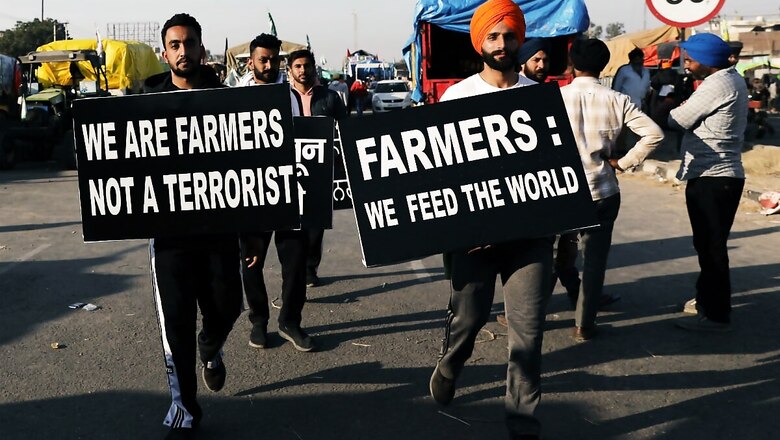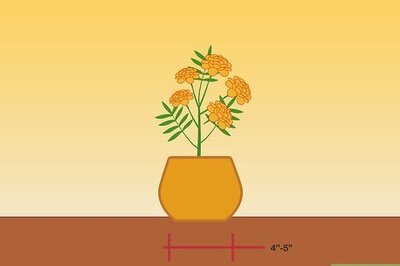
views
Thousands of farmers have been protesting the Centre’s three farm laws — The Farmers’ Produce Trade and Commerce (Promotion and Facilitation), The Farmers (Empowerment and Protection) Agreement of Price Assurance, and Farm Services and The Essential Commodities (Amendment). They are apprehensive that the laws would pave the way for dismantling of the minimum support price (MSP) system, leaving them at the “mercy” of big corporates.
The Centre allowed protesting farmers from Punjab and Haryana to enter the Capital and hold a protest demonstration at the Nirankari ground after they refused to turn back despite the police using tear gas and water cannons. The government also extended an invitation for talks on Tuesday.
Meanwhile, Prime Minister Narendra Modi has said his government is committed to provide a fair price to farmers through MSP and government procurement will continue as before. Here is why it is an absolute necessity for farmers.
WHAT IS THE BIGGEST FEAR?
The farmers have opposed the three contentious farm laws that were enacted by the Centre on September 27. They have been demanding to repeal the farm laws, alleging that none of the stakeholders was consulted before the enactment of the laws. Their biggest fear is the end of minimum support prices (MSP) procurement because of these laws. However, the Centre has denied any uncertainty regarding MSP. The Centre has time and again asserted that the laws will transform the agriculture system in India and will let farmers sell their produce anywhere in the country.
WHAT IS MSP?
MSP is essentially a form of market intervention undertaken by the government to provide a safety net to farmers in case of a price drop. It is a price for crops that the government guarantees to the farmers at all costs and under all circumstances. This week, the government is likely to announce the MSP for only Kharif crop since the Indian agricultural cycle is currently in the Kharif season.
The rise in MSP has been necessitated because of falling margins of profit for farmers, according to a report. This has caused widespread farm distress. The Centre aimed to double farmer incomes by 2022.
WHO SETS THE MSP?
The Swaminathan Committee’s original recommendation was to fix the MSP at levels “at least 50 per cent more than the weighted average cost of production”. However, the committee failed to define what constituted the weighted average cost of production.
The government fixes the MSP of 22 mandated agricultural crops based on the recommendation of the Commission for Agricultural Costs and Prices (CACP). The list of crops shielded by price fluctuations include 14 kharif crops, six rabi crops, and two commercial crops. The CCAP is also responsible for fixing the fair and remunerative price (FRP) of sugarcane. The CACP takes into consideration factors such as domestic and international prices, intercrop price parity, the overall demand-supply situation, and also the likely effect of the MSP on inflation.
HOW IS MSP CALCULATED?
According to the formula prescribed by the Swaminathan Committee, there are three variables that determine production cost – A2, A2+FL, and C2.
A2 includes out-of-pocket expenses borne by farmers, such as term loans for machinery, fertilisers, fuel, irrigation, cost of hired labour and leasing land.
The second metric, A2+FL, takes into account the imputed value of unpaid labour on the part of family members, in addition to the paid-out cost.
The Comprehensive Cost (C2) is more reflective of the actual cost of production since it takes it accounts for rent and interest foregone on owned land and machinery, over and above the A2+FL rate. The ideal formula according the Committee would be: MSP = C2+ 50% of C2.
WHY WAS THERE A NEED FOR MSP?
In 1960s, after India faced a food shortage due to multiple years of drought, policies were designed to maintain reserve stocks of food, providing price support to farmers by declaring, and procuring at minimum support price for various commodities and selling the grain at subsidised rates for those who cannot afford it.
HOW MUCH DOES THE GOVERNMENT BUY?
Of all the 24 commodities, government procurement is greatest for wheat and rice. The Centre procures about 30 per cent of all wheat and rice produced in the country and about 6-7 per cent of other commodities.
Read all the Latest News, Breaking News and Coronavirus News here


















Comments
0 comment